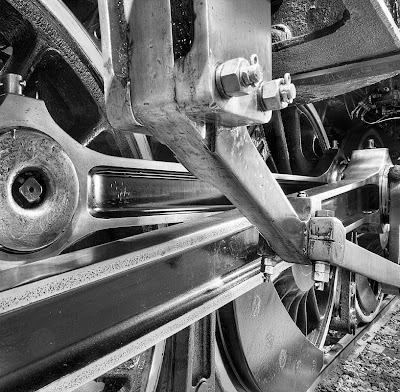
Some time ago I was photographing 2816, a steam engine, and the loved and polished locomotive had a wonderful sheen off of the drivers and other paraphenalia of the piston to wheels mechanisms. I took more than a dozen pictures and even picked a couple that looked nice to show. I have 'thumbed' through the image in Photoshop Bridge a number of times but this morning, instead of seeing pictures of 'drivers', I saw patterns and shapes and recognized that the centre of one of the images might work as an abstract.
I think this ability to see beyond the object and look at it in terms of shapes, shadows, lines, curves and edges is extremely important. Even when a photograph is quite literal - a picture of a mountain, for example, if you can see past the mountain and think of it in the above terms, composition is likely to be stronger.



7 comments:
This image didn't work so well as an abstract for me; it seemed too immediately recognizable. I prefer to have the initial impression be such that abstraction dominates, to the extent that it's not clear what the subject is until further attention has been paid. Do other share my predilection? That's just my taste, anyway. And it does work very well as an "ordinary" image, with the nearby parts so large they really emphasize strength.
I'll echo Steve's comment; but while it also doesn't quite work as an "abstract" your general point about "seeing it as such" during the act of composition I think is right on (at least for me). I believe you mentioned a while ago that (like me) you are nearsighted...if so, you also probably (like me) deliberately take off your glasses to just soak in the patterns and shapes before "looking" at a scene in earnest.
Getting back to *this* image: images such as this that can be looked at abstractly but, as Steve points our, clearly are not essentially compositional Necker cubes..the instant you think of it in one way it reverts back to the other. Ultimately, while not quite either real or abstract, this induced dynamism makes it all the more interesting.
While this image may be recognizable, that does not mean, at least to me, that it cannot be defined as an abstract. More importantly, if it works as an image, and this one does, why do we care how it is categorized?
Andrew (Ilachina) made an interesting comment, because I,too, am nearsighted. I have heard this before. Huntington Witherill, in an older LensWork interview, said that part of the reson that he is able to see the abstract shapes that compose his high key sand dune images is that he is so near sighted. He talks about it about 2/3 of the way through the interview here:
http://www.huntingtonwitherill.com/index.php
I gave the URL for the whole thing because I don't know if it is proper to cut and paste the few paragraphs in terms of copyright.
It is an interesting idea for all us near sighted folks!
It might be interesting to experiment with a fuzzy filter - some sort of viewing device which would frame, isolate and blur the object in a way that would facilitate composition (perhaps with a dial in monochrome filter while we're at it). What about a small camera with 3 inch screen, a monochrome mode and a fuzzy filter taped over the lens?
I love the tones, sharpness and "feel" of the coupling rods etc but it doesn't work fpr me as an abstract. Partly because that rather bland piece of linkage that leads the eye out of the lower right side of the frame, but mainly because as a locomotive fan I want to see and know more about the loco.
Last week I visited a steam depot here in the UK and found a tension between the photographer in me (looking for shapes, tones and lighting) and the railfan just immersing myself in the sheer enjoyment of the engineering artistry of a bygone age.
Can I see more of your railroad pics in coming weeks, please?
There is a kind of abstraction from the concrete that in fact enhances or emphasises and brings forward sensations touching on the literal image. Here is a great Wayne Leeman picture that is both visually recognisable and conveys the sensation of touching hot pitted metal:
http://enginemanwook.wordpress.com/2009/12/07/some-artists-of-steam/
Post a Comment